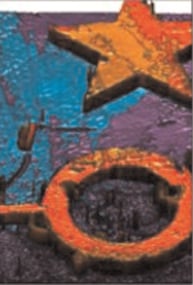
As we noted back in April, Richard Feynman in his classic 1959 talk challenged his fellow physicists to make the electron microscope 100 times better. A “new super powerful electron microscope that can pinpoint the position of single atoms” had been unveiled at a facility in the UK. While that SuperSTEM is one of only three in the world, a recently demonstrated technology based upon “tabletop extreme-ultraviolet ptychography” brings complementary nanometer-scale resolution to a much smaller (and presumably less expensive) instrument. A hat tip to John Faith for bringing this EETimes article by R Colin Johnson to our attention “EUV Breaks Through to Angstrom“:
The wavelength of visible light — 400-to-700 nanometers — makes it impossible with today’s tools to take photographs of nanoscale objects with any sort of reasonable resolution. The answer has been to use scanning electron microscopy (SEM) and atomic force microscopy (ATM), which yield reasonable images. These tools, however, produce nothing close to the angstrom-level (tenth of a nanometer) resolution of a new type of microscope that uses femtosecond pulses of extreme ultraviolet light (EUV) — the same wavelength light to be used for sub-10 nanometer semiconductor lithography.] …
The claim made here of angstrom-level resolution appears to be a substantial overstatement of the published result (see below). Nevertheless, the technique does appear to offer substantial advantages, and may approach this resolution in the near future.
This amazing breakthrough … was made possible by a grant from the Semiconductor Research Corp. (SRC) to scientists at the University of Colorado (Boulder) who invented the EUV microscope, namely Margaret Murnane, professor of physics and electrical and computer engineering and Henry Kapteyn, professor of physics and electrical and computer engineering there.
“SRC is very happy with results of this experiment,” Kwok Ng, senior science director of Nanomanufacturing Materials and Processes at SRC told EE Times. “In general when you go to less than 10-nm features, it is a big problem to image them. The fact that the EUV microscope is a table-top device will be a big boon to the industry.” …
“The EUV laser-like beams can be used for defect detection either standalone or as an inline tool during manufacturing,” Kapteyn told EE Times. “The high-contrast, full-field, real-time images of functioning circuits and nano systems will advance the state-of-the-art in fabrication applications.”
The Open Access research report “High contrast 3D imaging of surfaces near the wavelength limit using tabletop EUV ptychography” is published in the journal Ultramicroscopy. Coherent diffractive imaging (CDI) is presented as a new full field imaging technique that can achieve very high spatial and temporal resolution simultaneously.
As explained in the research paper, the resolution approaches the angstrom scale only in the axial direction, where it is estimated at 0.6 nm. In the lateral directions it is only 40 nm. However, the temporal resolution is indeed near the femtosecond scale ( 1 fs = 10-15 s). A spatially coherent beam from fs pulses of a tabletop extreme ultraviolet laser illuminates an object, the intensity of the scattered light is collected on a pixel array detector, and the data is computationally interpreted to provide quantitative amplitude and phase contrast information about a surface or object. Pthychography CDI acquires diffraction patterns from several adjacent overlapping positions, making it possible to solve the phase retrieval problem. Including this information from the reflected complex exit surface wave provides additional information about the surface composition and contrast.
The other part of the process, as explained in the paper, is using the high harmonic generation process to produce bright spatially coherent beams from a tabletop laser, spanning the range from the vacuum ultraviolet (wavelengths less than 200 nm) to the soft X-ray region of the spectrum (wavelengths less than 10 nm)
This paper demonstrates “high contrast, high quality, full field 3D imaging of surfaces” by combining the tabletop laser source of coherent harmonics at a wavelength of 30 nm with ptychographic CDI. The current resolution is 0.6 nm axially and 40 nm laterally, combined with a long working distance of 3 to 10 cm. The authors claim that “this work will make it possible to image the fastest charge, spin and phonon dynamics in functioning nanosystems in real space and time”
It will be interesting to see if this technology improves to the point of resolving individual atoms and their movements, especially in the rapid dynamic processes that occur at the nanoscale.
—James Lewis, PhD


